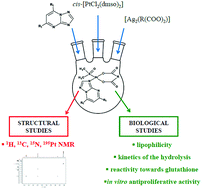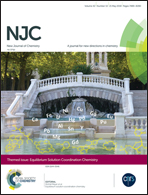Dicarboxylato platinum(ii) complexes containing dimethyl sulfoxide and triazolopyrimidine as potential anticancer agents: synthesis, structural and biological studies in solution†
Abstract
Four dicarboxylato platinum(II) complexes of the general formula [Pt(R(COO)2)(dmso)(N-donor)], where: R(COO)2 – cyclobutane-1,1-dicarboxylato or malonato, dmso – dimethyl sulfoxide and N-donor – 5,7-dimethyl-1,2,4-triazolo[1,5-a]pyrimidine (dmtp) or 5,7-diphenyl-1,2,4-triazolo[1,5-a]pyrimidine (dptp), have been synthesized and structurally characterized using multinuclear magnetic resonance (1H, 13C, 15N, and 195Pt) techniques. The NMR parameters unambiguously confirmed the square-planar geometry of Pt(II) in solution with monodentate N(3)-bonded 5,7-disubstituted-1,2,4-triazolo[1,5-a]pyrimidine, monodentate and S-bonded dimethyl sulfoxide and O,O-chelating dicarboxylate ions. The obtained platinum(II) complexes exhibit (i) higher susceptibility to hydrolysis and (ii) lower toxicity and affinity to glutathione in comparison with cisplatin and carboplatin. Additionally, it is noted that two lipophilic platinum(II) complexes: (3) [Pt(mal)(dmso)(dptp)] and (4) [Pt(CBDC)(dmso)(dptp)] display the most gratifying in vitro antiproliferative activity. Above and beyond, these promising coordination compounds exhibit definitely lower toxicity towards normal cells and anticancer activity comparable to that of cisplatin.

- This article is part of the themed collection: Equilibrium Solution Coordination Chemistry


 Please wait while we load your content...
Please wait while we load your content...